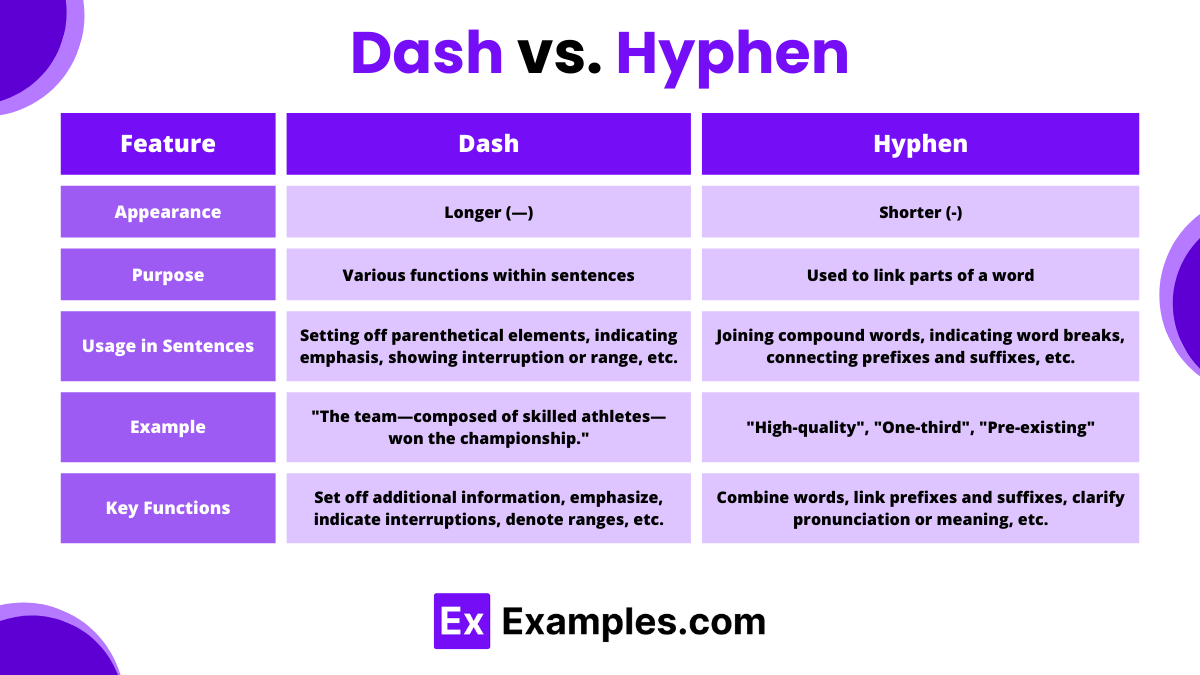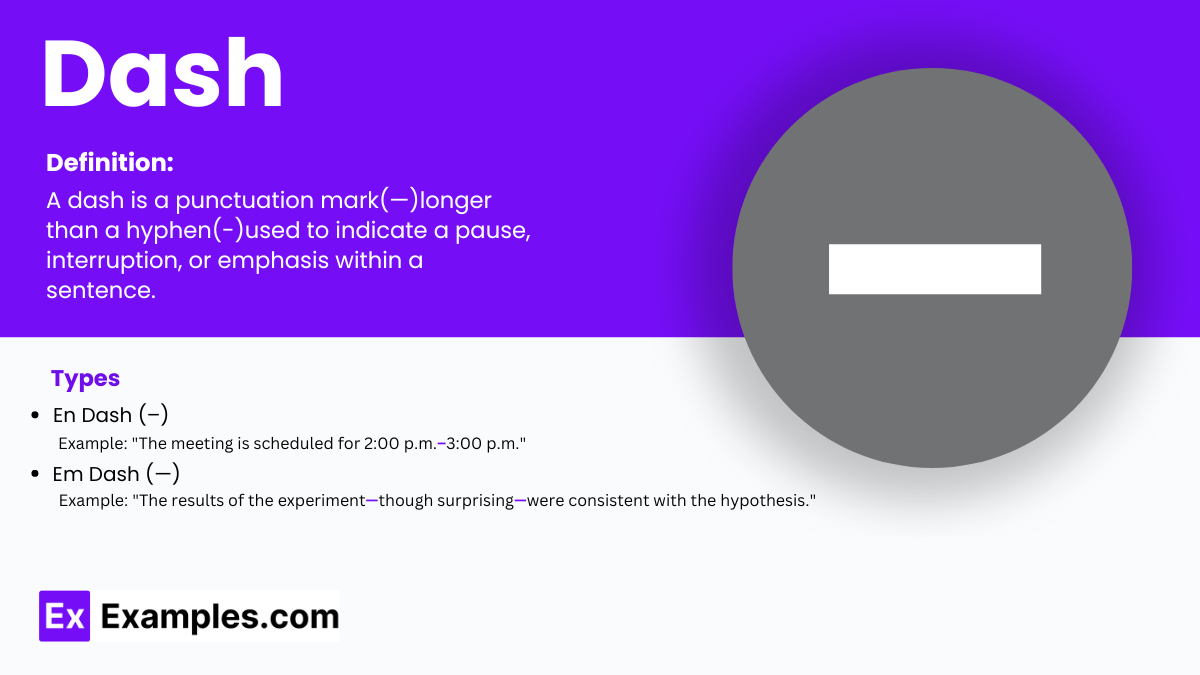Dash
The dash, a versatile punctuation mark, serves multiple functions in English grammar. Primarily, it introduces additional information or emphasizes elements within a sentence. There are two types of dashes: the en dash (–) and the em dash (—). The en dash typically indicates ranges, such as dates or numbers, while the em dash is used to create a break in a sentence, similar to parentheses or commas, but with a stronger separation. Effective use of the dash can enhance clarity and add stylistic flair to writing, making it a valuable tool in both informal and formal contexts.
What is a Dash Symbol?
A dash is a punctuation mark used in English grammar to introduce additional information or emphasize elements within a sentence. There are two main types: the en dash (–), which indicates ranges, and the em dash (—), which provides a strong separation in sentences, enhancing clarity and style.
Grammatical Functions of a Dash
The dash serves several important grammatical functions, enhancing the clarity and style of writing. Here’s how it operates:
- Parenthetical Elements: Dashes can set off parenthetical elements within a sentence. For example: “The concert — which lasted three hours — was a huge success.” In this case, the dash provides additional information about the duration of the concert.
- Emphasis: Dashes can emphasize a particular word or phrase within a sentence. For instance: “His ideas — radical and groundbreaking — sparked a revolution in the field.” Here, the dashes draw attention to the adjectives describing his ideas.
- Interrupted Thought: Dashes can indicate an interrupted thought or abrupt change in direction. For example: “I was going to call her, but then — I remembered she’s out of town.” The dash signals a sudden shift in the speaker’s thought process.
- Lists: Dashes can replace commas or semicolons to introduce items in a list, especially when the items themselves contain commas. For instance: “The ingredients for the recipe included flour, sugar, and eggs — all essential for baking.”
- Range: Dashes can denote a range between two numbers, dates, or other elements. For example: “Please refer to pages 50–60 for more information.” Here, the dash indicates the range of pages.
- Attribution or Source: In dialogue or quoted text, a dash can signify attribution or source. For example: “She said, ‘I’ll be there at 9:00’ — her exact words.” The dash indicates that the following phrase is attributed to the speaker.
Importance of Dash Symbol
The dash symbol holds significant importance in written communication due to its versatile functions and contributions to clarity, emphasis, and style. Here are some key reasons why the dash symbol is important:
- Enhanced Clarity: Dashes help to set off parenthetical elements, providing additional information within a sentence without disrupting its flow. This clarity aids readers in understanding the intended meaning and context of the text.
- Emphasis and Attention: By emphasizing particular words or phrases, dashes draw attention to essential points or ideas, helping to highlight key concepts within a sentence. This emphasis can make the writing more impactful and memorable.
- Smooth Transition and Flow: Dashes facilitate smooth transitions between clauses or thoughts, allowing for a more fluid and cohesive narrative. They help to connect ideas seamlessly, maintaining the reader’s engagement and comprehension.
- Concise Punctuation: Dashes offer a concise alternative to other forms of punctuation, such as parentheses or commas, making them particularly useful for writers aiming to convey information efficiently while avoiding ambiguity.
- Stylistic Variation: The dash symbol adds stylistic variation to writing, allowing authors to express their unique voice and creativity. Whether used sparingly for emphasis or more liberally for parenthetical elements, dashes contribute to the overall tone and rhythm of the text.
- Versatility in Usage: From setting off lists to indicating interrupted thoughts or ranges, the dash symbol offers versatility in its usage, adapting to a wide range of grammatical and stylistic contexts. This flexibility makes it a valuable tool for writers across various genres and discipline
When Do We Use Dash Symbol?
The dash symbol, often represented as “—”, is used in writing for several purposes:
- To Set Off Parenthetical Elements: Dashes can be used to set off parenthetical elements within a sentence. These are non-essential phrases or clauses that provide additional information. For example: “The team — consisting of experienced professionals — won the championship.”
- To Indicate Emphasis: Dashes can emphasize a particular word or phrase within a sentence, drawing attention to it. For instance: “She was determined to succeed — no matter the obstacles.”
- To Show Interrupted Thoughts or Dialogue: Dashes can indicate an interruption or abrupt change in thought within a sentence or dialogue. For example: “I was about to leave the house when — oh, I forgot my keys!”
- To Replace Other Punctuation Marks: Dashes can replace commas, colons, or parentheses to introduce a list, explanation, or attribution. For instance: “The ingredients for the cake included flour, sugar, and eggs — all essential for baking.”
- To Denote a Range: Dashes can indicate a range between two numbers, dates, or other elements. For example: “Please refer to pages 50–60 for more information.”
- To Introduce a Summary or Conclusion: Dashes can introduce a summary or conclusion at the end of a sentence. For example: “The results were clear — we needed to reevaluate our strategy.”
- To Create Dramatic or Suspenseful Effects: Dashes can be used to create dramatic or suspenseful effects in storytelling or narrative writing. For example: “The door creaked open slowly — revealing the hidden secrets within.”
How to Use Dash Symbol?
Using the dash symbol effectively in writing requires attention to its various functions and appropriate placement within sentences. Here’s how to use the dash symbol:
- Insert the Dash: In most word processing software, you can insert a dash symbol by typing two hyphens “–” with no spaces before or after, or by using the dedicated dash symbol (—”em dash”) provided by the software.
- Set Off Parenthetical Elements: Use a dash to set off parenthetical elements within a sentence. These are non-essential phrases or clauses that provide additional information. Example: “The team—composed of skilled athletes—won the championship.”
- Indicate Emphasis: Use a dash to emphasize a particular word, phrase, or clause within a sentence, drawing attention to it. Example: “She was determined—nothing could stop her.”
- Show an Interrupted Thought or Dialogue: Use a dash to indicate an interruption or abrupt change in thought within a sentence or dialogue. Example: “I was about to leave the house when—oh, I forgot my keys!”
- Replace Other Punctuation Marks: Use a dash instead of other punctuation marks like colons, semicolons, or commas to introduce a list, explanation, or attribution. Example: “Please bring the following items—blanket, flashlight, and water.”
- Denote a Range: Use a dash to indicate a range between two numbers, dates, or other elements. Example: “Please refer to pages 10–15 for more information.”
- Introduce a Summary or Conclusion: Use a dash to introduce a summary or conclusion at the end of a sentence. Example: “The results were clear—further investigation was unnecessary.”
- Create Dramatic or Suspenseful Effects: Use a dash to create dramatic or suspenseful effects in storytelling or narrative writing. Example: “The clock struck midnight—the moment of truth had arrived.”
Dash vs. Hyphen

| Feature | Dash | Hyphen |
|---|---|---|
| Appearance | Longer (—) | Shorter (-) |
| Purpose | Various functions within sentences | Used to link parts of a word |
| Usage in Sentences | Setting off parenthetical elements, indicating emphasis, showing interruption or range, etc. | Joining compound words, indicating word breaks, connecting prefixes and suffixes, etc. |
| Example | “The team—composed of skilled athletes—won the championship.” | “High-quality”, “One-third”, “Pre-existing” |
| Key Functions | Set off additional information, emphasize, indicate interruptions, denote ranges, etc. | Combine words, link prefixes and suffixes, clarify pronunciation or meaning, etc. |
Different Types of Dash Symbols
There are primarily two types of dash symbols commonly used in writing: the en dash and the em dash. Here’s a brief overview of each:
- En Dash (–):
- Appearance: Slightly longer than a hyphen but shorter than an em dash.
- Usage:
- Denotes ranges between numbers or dates: “Pages 10–15”, “Monday–Friday”.
- Indicates connections or relationships: “The London–Paris flight”, “The New York–based company”.
- Shows scores or results: “The Lakers beat the Celtics 100–90”.
- Example: “The meeting is scheduled for 2:00 p.m.–3:00 p.m.”
- Em Dash (—):
- Appearance: Longer than an en dash.
- Usage:
- Sets off parenthetical elements within a sentence: “She was determined—despite the odds—to succeed.”
- Indicates an interruption or abrupt change in thought: “I was about to leave—wait, did I forget my keys?”
- Adds emphasis or highlights a particular phrase: “The winner—announced last night—will receive a cash prize.”
- Example: “The results of the experiment—though surprising—were consistent with the hypothesis.”
Examples of Dash Symbol in Sentences
- The city – bustling, vibrant, and full of life – never failed to captivate visitors.
- She had one goal in mind – to climb the highest peak in the region.
- The novel – a gripping tale of love and betrayal – kept readers on the edge of their seats.
- After years of hard work, she finally achieved her dream – owning her own business.
- The project deadline – originally set for next month – was moved up due to unforeseen circumstances.
- His passion – photography – led him to travel the world capturing breathtaking landscapes.
- The meeting agenda – discussing budget allocations and future projects – was distributed to all attendees.
- The storm – unexpected and fierce – caused widespread damage across the city.
- Despite the challenges – financial setbacks and personal struggles – she remained resilient and determined.
- Their friendship – built on trust, loyalty, and mutual respect – stood the test of time.
Examples of Dash Symbol in Writing
- Setting off parenthetical elements:
- “The city – with its towering skyscrapers and bustling streets – never sleeps.”
- Indicating emphasis:
- “She was determined – against all odds – to succeed.”
- Showing an interrupted thought:
- “I was about to leave the house when – wait, did I forget my keys?”
- Replacing other punctuation marks:
- “The ingredients – flour, sugar, and eggs – were all laid out on the kitchen counter.”
- Denoting a range:
- “Please refer to pages 50–60 for more information.”
- Creating a dramatic effect:
- “The castle loomed over the horizon – dark, foreboding, and mysterious.”
- Setting off a list:
- “The colors of the sunset – red, orange, and pink – painted the sky in a breathtaking display.”
- Introducing a summary or conclusion:
- “The results were conclusive – further experimentation was unnecessary.”
- Connecting related ideas:
- “The author explored various themes – love, loss, and redemption – throughout the novel.”
- Providing additional information:
- “The event – a fundraiser for charity – was attended by hundreds of people.”
What is the rule for Dashes in Grammar?
Dashes are used to set off parenthetical elements, indicate emphasis or interruption, replace other punctuation marks, denote ranges, connect related ideas, and provide additional information, contributing to clarity, emphasis, and coherence in writing.
Why are Dashes used in Speeches?
Dashes are used in speeches to add emphasis, create dramatic pauses, or indicate an interruption, enhancing the speaker’s delivery and engaging the audience with dynamic and expressive communication.
When not to use Dashes?
Dashes should be avoided when simpler punctuation like commas or parentheses suffices. Overuse can disrupt flow and clarity. In formal writing, adhere to style guides; excessive dashes may detract from professionalism and readability.



